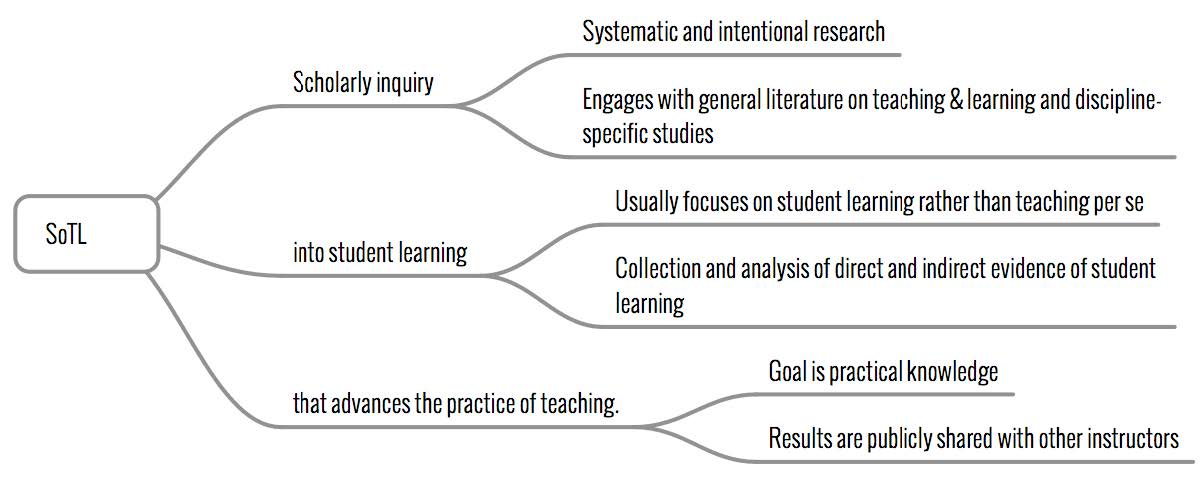The Classroom as a Research Setting: The Scholarship of Teaching & Learning Benefits Our Students

At Lafayette College excellence in undergraduate teaching is part of our DNA as we seek to provide remarkable educational experiences to the students that we have the pleasure to teach. This newsletter focuses on the scholarship of teaching and learning (SoTL). SoTL involves conducting systematic inquiries on individual or collaborative teaching efforts to provide insights into what works in the classroom to promote student learning. Faculty members can disseminate the findings of their SoTL projects publicly through venues such as conferences and publications. The beauty of SoTL is that it can be conducted by any faculty member who teaches, and projects can be designed to align with current course activities. SoTL work can also be intentionally planned to suit the time frame of the faculty member.The illustration below highlights the major attributes of SoTL. This newsletter describes why SoTL is meaningful work for faculty members. Also highlighted are sample SoTL efforts of members of our community.

Image Source: David J. Voelker
Why conduct SoTL, and what does it look like at Lafayette?
There are a number reasons as to why faculty members may choose to conduct SoTL. In a study of SoTL champions, Marcketti, Van Der Zande, and Leptient (2015) found that instructors engaged in such work had high teaching loads and wanted better measurements of whether their instructional practices were effective. The reasons why they performed SoTL included: “[f]inding community, opportunities to impact students and future colleagues, and being known outside of disciplinary circles” (p. 16). At Lafayette, faculty members engaged in SoTL express similar sentiments. Their projects provide them with opportunities to learn more about what makes their teaching effective, and to hold cross-disciplinary conversations with others interested in such work. The current COVID-19 pandemic can also inspire new possibilities for SoTL projects at various levels given increased experimentation with teaching approaches.
There are several examples of faculty members who are also scholars within their disciplines and also perform SoTL. The Lafayette Digital Repository recently launched by Skillman Library has several examples of this work. Please see the current articles available in the repository through a search of the key terms “teaching and learning.” Faculty and staff members may engage in collaborations around SoTL projects, as well as employ student researchers to work on such projects.
How can faculty members take a stepwise approach to SoTL and become part of a community of practitioners?
Members of the Lafayette community, either new or experienced in SoTL, are welcome to contact CITLS and be part of the SoTL faculty community of practice that meets virtually this semester. The community meets roughly monthly during the semester to provide dedicated time to design, receive feedback, and work on SoTL projects. All members of the community of practice are provided the resource Engaging in the Scholarship of Teaching and Learning: A Guide to the Process, and How to Develop a Project from Start to Finish which offers step-by-step guidance on developing and conducting a SoTL project. CITLS will also support community of practice members interested in SoTL to register to attend the Scholarship of Teaching and Learning Virtual Summit in October 2021 to learn more about SoTL or present if desired. Faculty members may consider presenting SoTL work at their disciplinary conferences that they are also attending if they offer such opportunities.
For more information about the scholarship of teaching and learning at Lafayette, please visit the CITLS website.
Let’s continue to advance the scholarship of teaching and learning at Lafayette.
Reference
Marcketti, S; VanDerZanden, AM; and Leptien, JR. (2015). SoTL Champions: Leveraging Their Lessons Learned. International Journal for the Scholarship of Teaching and Learning, 9(1), Article 4. Available at: https://doi.org/10.20429/ijsotl.2015.090104